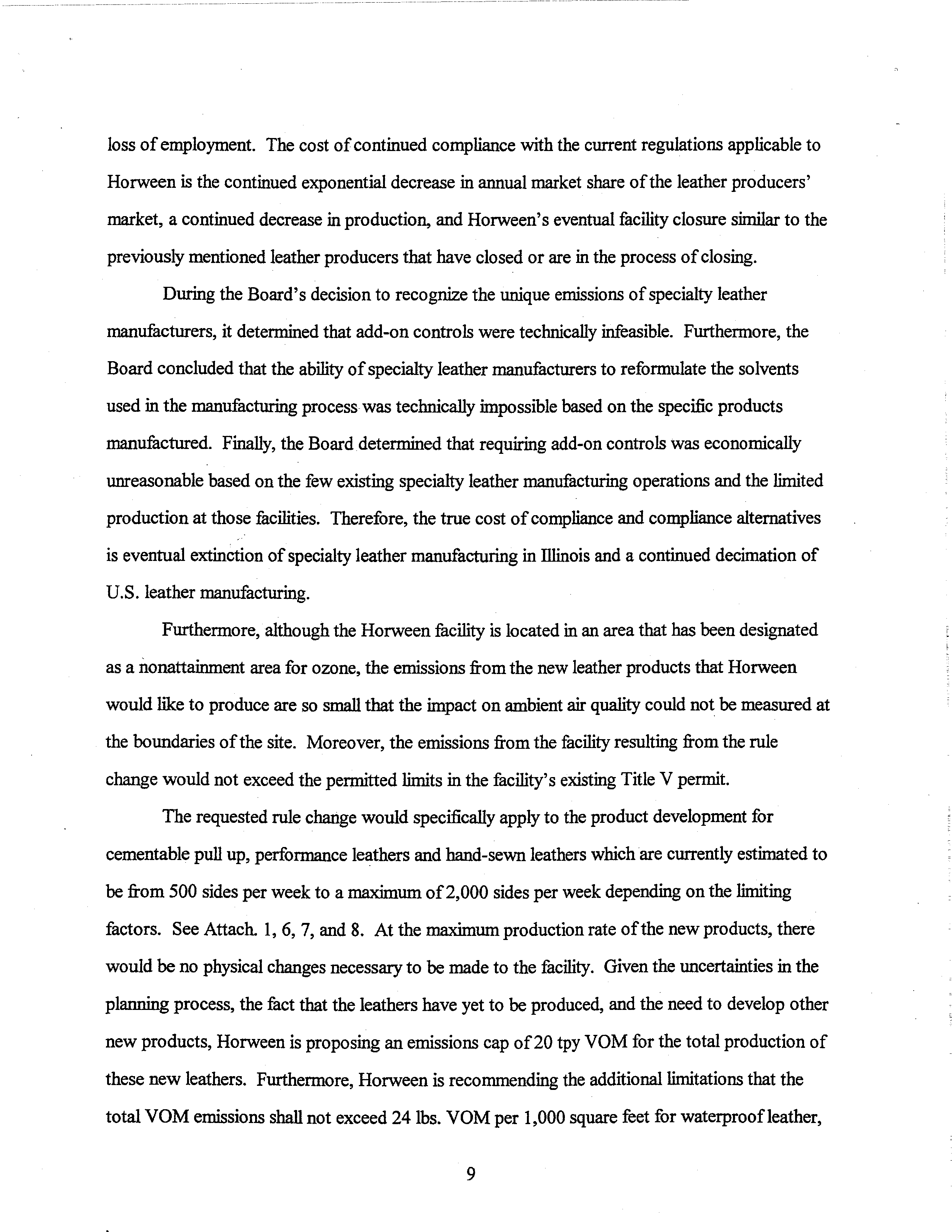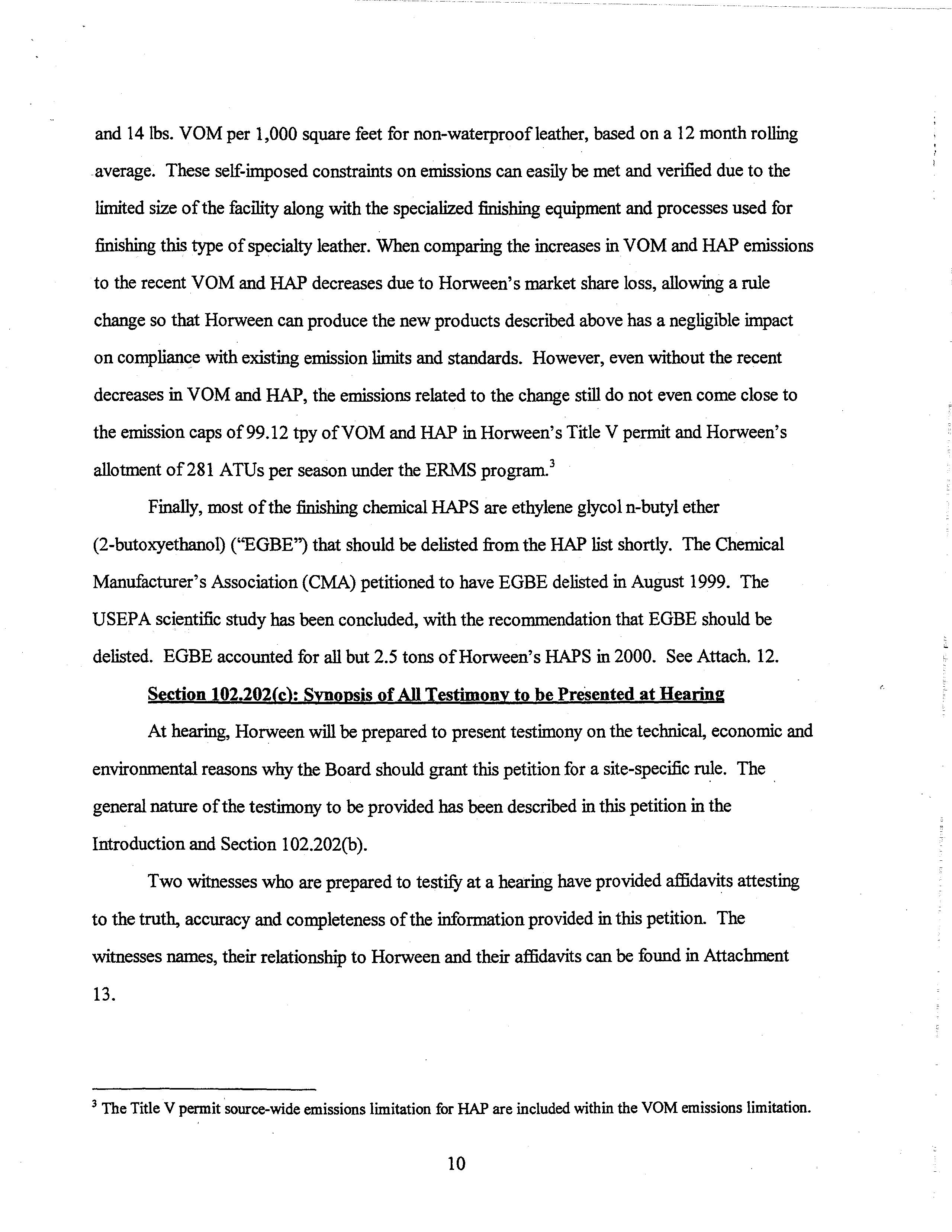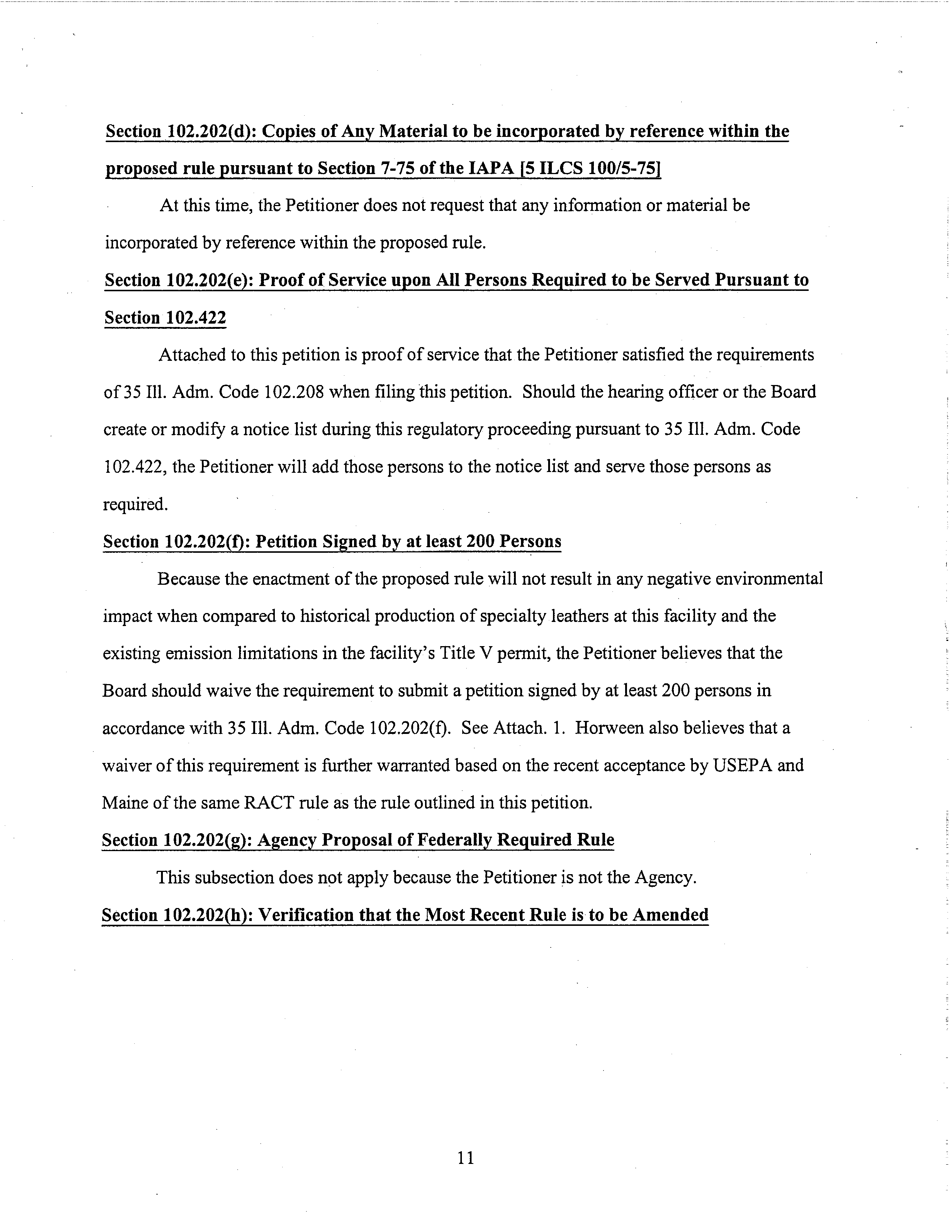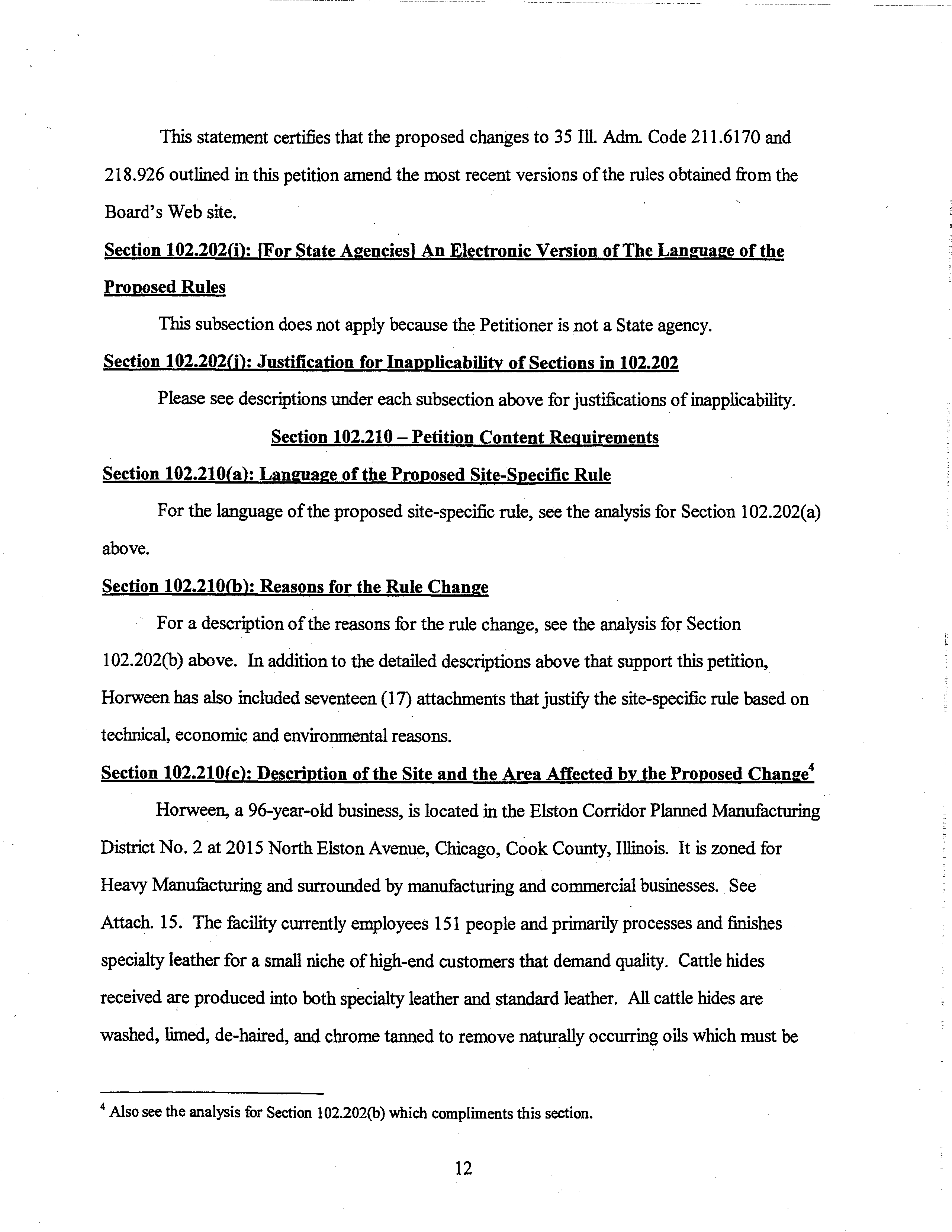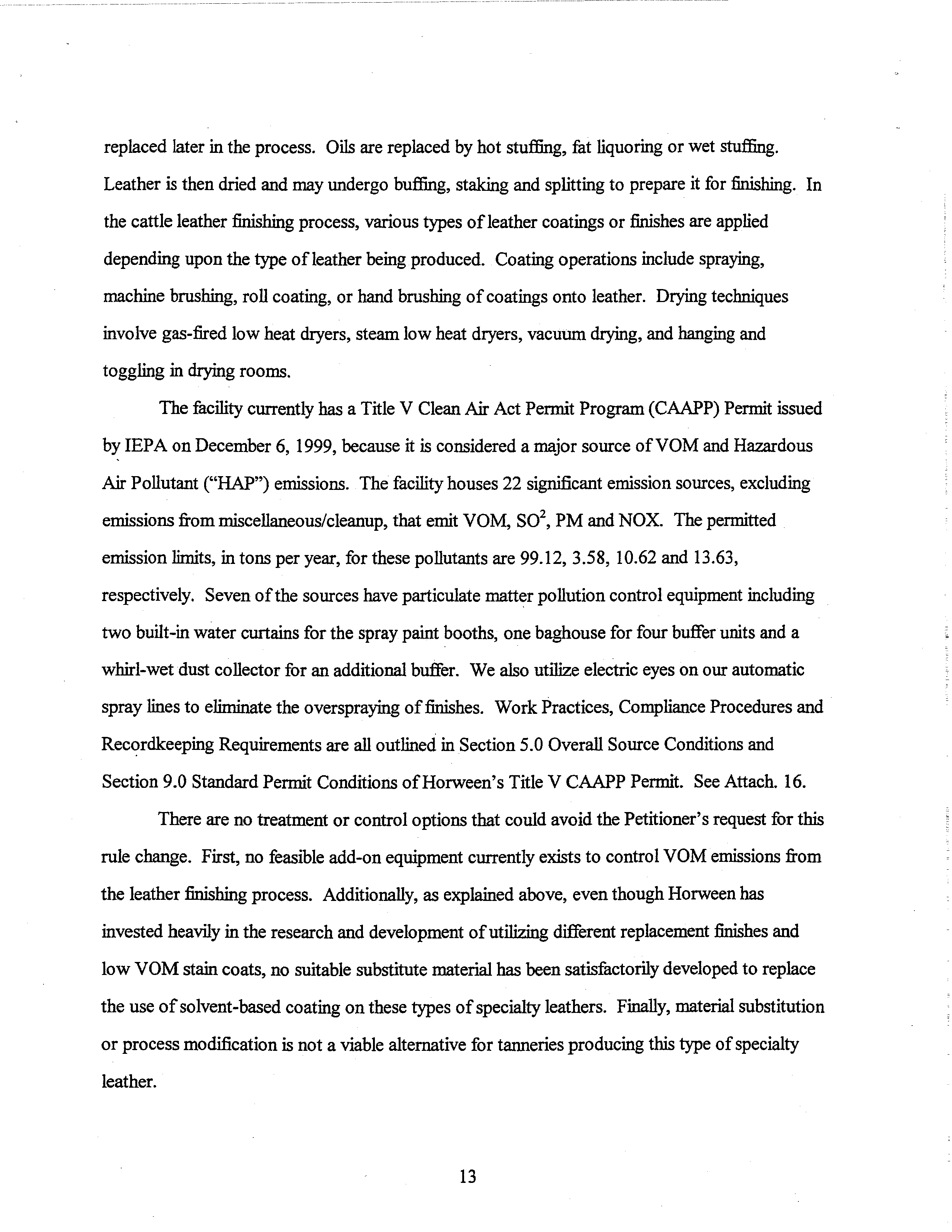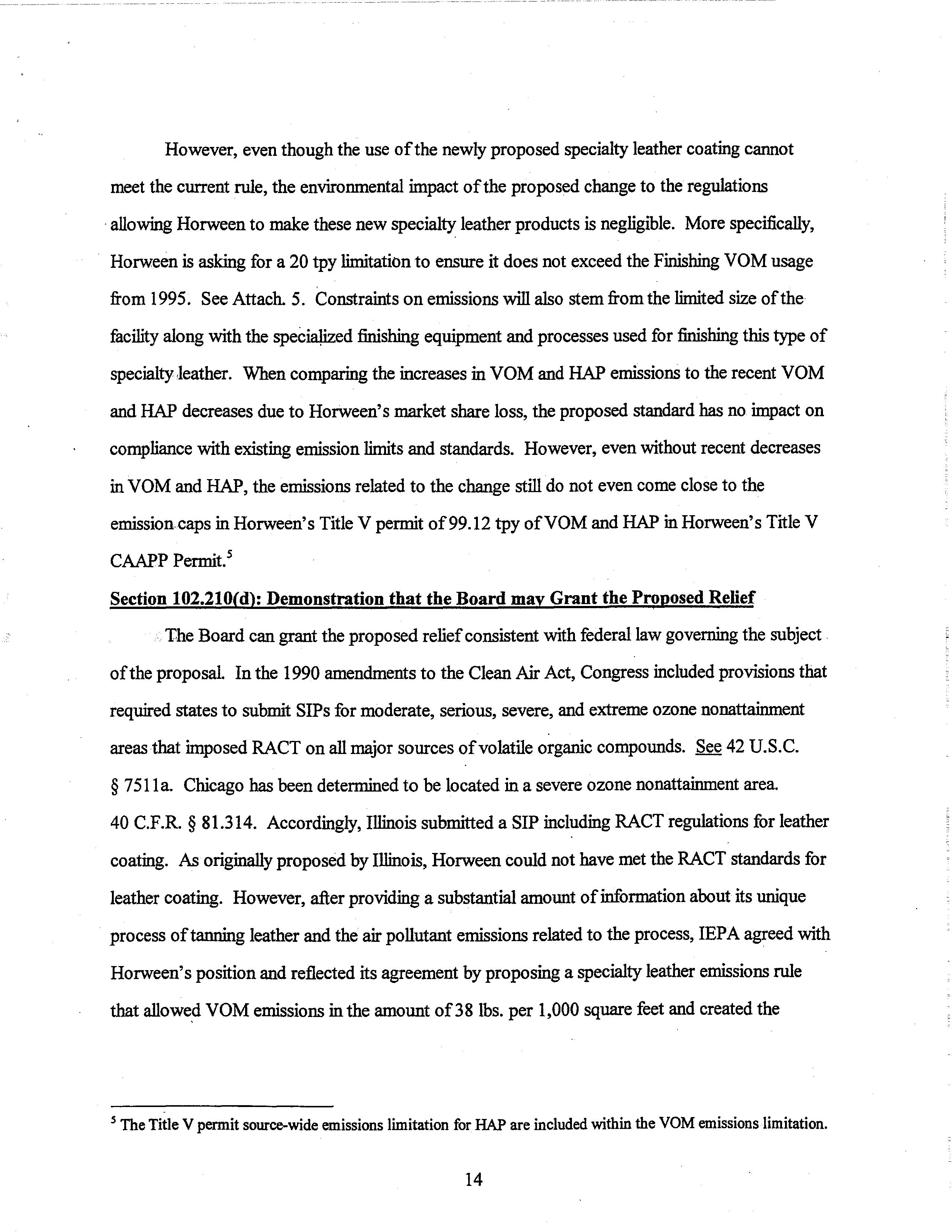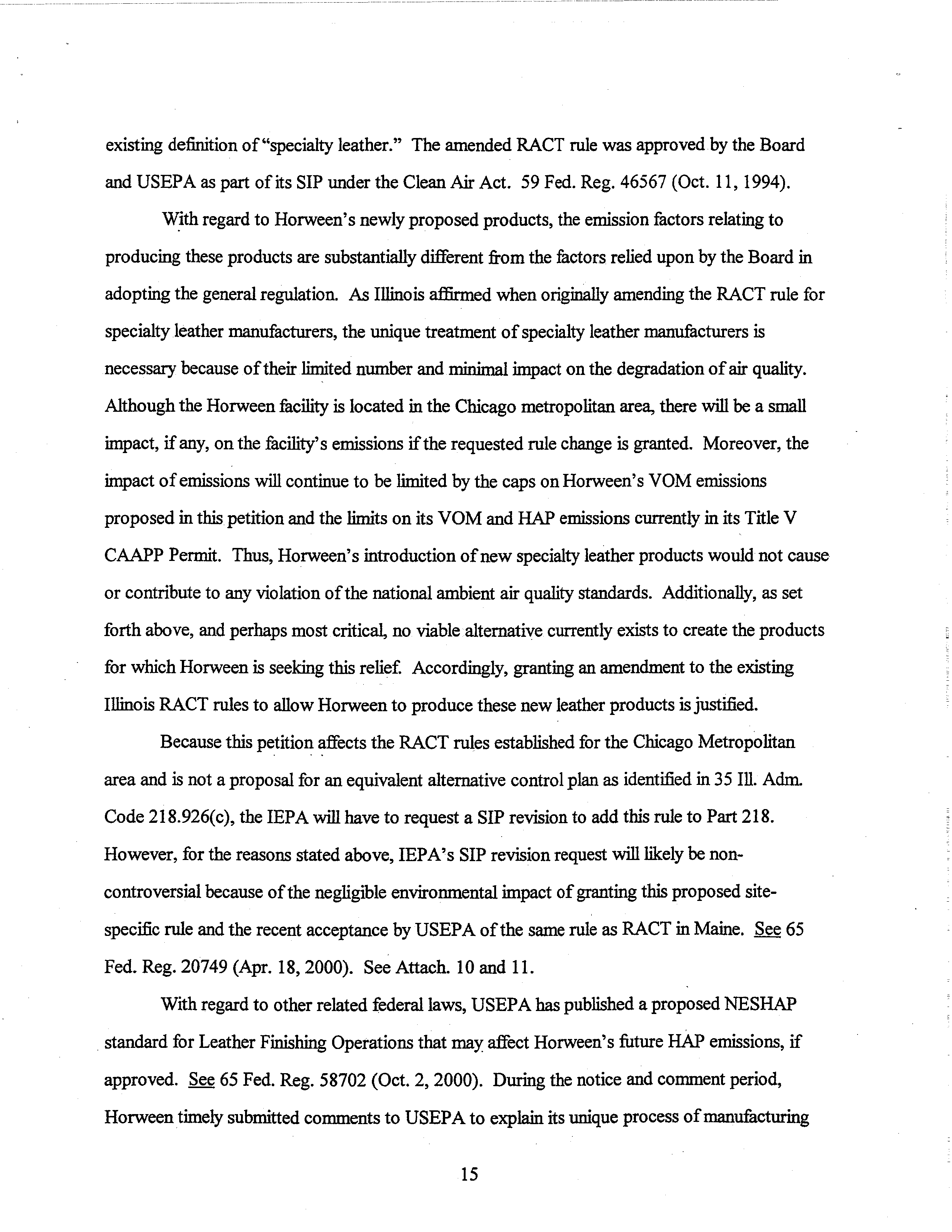RECEIVED
(‘T
F~~5
OFFiCE
1
9
2002
bit~1h
01.:
ILLINOIS
iN THE
MATTER OF:
ttIOn
Control Boarj
PROPOSED
SITE SPECIFIC•
R02-
~2
AIR POLLUTION REGULATIONS
(Site-Specific Rulemaking
-
Air)
APPLICABLE TO HORWEEN
LEATHER COMPANY OF
CHICAGO, ILLiNOIS
35
Iii. Adm.
Code 211.6170
NOTICE OF FILING
TO:
Clerk, Illinois Pollution Control Board
Illinois Environmental
Illinois Department of
State of Illinois Center
Protection Agency
Natural Resources
100 West Randolph Street
1021 N. Grand Ave. East
524
South Second Street
Suite 11-500
Springfield,
IL
62702
Springfield, IL
62701-1787
Chicago, IL
60601
Illinois Attorney General
500
South Second Street
Springfield, IL 62706
PLEASE
TAKE
NOTICE
that on Tuesday, February 19,2002, we filed the attached
Petition for Site-Specific Rulemaking with the Clerk of
the
Illinois Pollution Control
Board,
a copy ofwhich is herewith served upon you.
Roy M. Harsch
Steven J. Murawski
GARDNER, CARTON & DOUGLAS
321 North Clark Street
Chicago, Illinois
60610
(312) 644-3000
II
BEFORE THE
ILLINOIS
)
)
)
)
)
)
)
submitted,
Attorneys
THIS FILING
IS SUBMITTED ON
RECYCLED PAPER
~ECE~VED
BEFORE THE ILLINOIS POLLUTION CONTROL BOARD
~
orric~
FEB 19200
IN THE MATTER OF:
)
SThfE OF ILLINOIS
PROPOSED SITE SPECIFIC
)
R02-
~-D
Pollution
Control
Board
AIRPOLLUTION REGULATIONS)
(Site-Specific Rulemaking
-
Air)
APPLICABLE TO HORWEEN
)
LEATHER COMPANY OF
)
CHICAGO, ILLiNOIS
)
35111.Adm.Code2ll.6170
)
PETITION
FOR
SITE-SPECIFIC RULEMAKING
HorweenLeather Company (“Horween”) hereby petitions the Illinois Pollution Control
Board (“Board”) for a Site-Specific Rule pursuant to 35 III. Adm.
Code
Part
102,
Subpart B and
Sections 27 and 28 ofthe Illinois Environmental Protection Act,
415
ILCS
5/27-5/28
(“Act”).
Horween requests that the Board issue a site-specific rule from 35
III. Adm.
Code 211.6170 and
218.926 to change the controlrequirements as applied to a small amount ofnew specialty leathers
that Horweenwould like to produce.
The requested rule changewould allowHorweento
continue to produce its existing specialty leathers pursuant to the existing regulations, and
develop new specialty leatherproducts in compliance with environmental law pursuant to these
requested regulations.
Introduction
Horween is
submitting
this petition based on inherent technical restraints associated
with
making
newtypes of
specialty
leatherto meet customers’
demands
driven bythe
fhshion industry.
The severe economic
downturn
in theU.S.
leather
industry has greatly
reduced the productionof
leather and, as a result, the
viability
ofHorween’s
business.
In addition, there is a negligible
environmental impact in
allowing
Horween to produce these new
specialty
leather products.
In
reality, Horweenwould not exceed volatile organic
material
(““TOM”) emission levels of
five
years ago.
Horween, located in Chicago, Illinois, produces
specialty
leathers for a
small
niche of
customers
that
demand
quality.
It is extremely h
rtant that
Horweenbe
able to produce
additional “specialty-type” leathers to support its business.
Between
1995
and 2000, Horween
has experienced a marked reduction offootage shipped:
6,950,128
to 4,780,291, respectively.
See Attachment (“Attach.”) 1.
To remain a viable business, Horweenmust constantly change its
products to meet the demands ofits customers.
As part ofthe market-driven changes and in
order to continue to be
a viable entity, Horween needs to be able to
finish a larger variety of
specialty-type leathers including
cementable pull up, leathers designed for hand-sewn shoes, and
other performance leathers that were not considered in the existing ReasonablyAvailable Control
Technology (“RACT”) rule or the amendment to
the RACT rule that included the definition of
specialty leather and
established a separate RACT rule for such leather.
The rapid decline in the U.S. leather manufacturing industry has created
extreme economic
uncertainty for all tanneries in the U.S.
Since 1994,
over one-halfofthe side leather production in
this country has been lost.
See Attach. 2 and 3.
For
example, in
1999 only 120 million out of
1,767 billion shoes consumed were domestically produced.
As a result ofthe increasing offshore
leather production and the relocation ofleather customers overseas, the U.S. domestic
side
leather industry has been in the process ofrapid consolidation.
Since 1998, at least eight major
leather producers have closed or are closing.
The leather producers that have already closed
include A.L. Gebhardt, Pflster & Vogel, Whitehall Tanning, Salz Leathers, and Lackawanna
Tanning.
Additionally, this year, Midwest Tanning announced plans to move to China and
Blackhawk Tanning will be closing.
Finally, Irving Tanning, a direct competitor ofHorween, just
filed for Chapter
11 bankruptcy this summer,
Paul
Flagg Tanning is
for sale
and Prime Tanning
began ceasing domestic operations at the end ofthe 2001.
See Attach. 4.
The inherent production requirements ofleathers that use higher solvent-based finishes
were the subject ofIllinois’ original adoption ofamendments to the generally applicable RACT
leather coating rule.
See 35
III. Adm. Code
§~
218.926 and 211.6170; Board Order, PCB R.93-
14, January 6,
1994.
Horween worked extensively with the Illinois Environmental Protection
Agency (“JEPA” or “Agency”) in that procedure and testifiedbefore the Board.
The Board, after
thoroughly evaluating the required production needs ofspecialty leathers with a high grease, wax
2
and oil content, adopted a special
subcategoryfor this “specialty leather.”
~
35 Ill. Adm. Code
§~
218.926 and 211.6170.
The Illinois rule allows emission ofVOM in the amount of38 pounds
(“lbs.”) per 1,000 square feet and further provides an exemption for the stains used on leather.
35
Ill. Adm.
Code
§
2 18.926.
Furthermore, the rule specifically defines “specialty leather.”
35
III.
Adm.
Code
§
211.6170.
This particular rule was approved by the U.S.
Environmental Protection
Agency (“USEPA”) and included in the Illinois
State Implementation Plan (“SIP”).
59 Fed.
Reg.
46567
(Oct.
11,
1994).
During that rulemaking process, the IEPA and ultimately the Board
agreed that further solvent reductions and add-on control technology were not feasible and would
create an undue burden upon specialty leather manufacturers.
Thus, the Board enacted the
Specialty Leather Ruleto provide reliefto these manufacturers from the generally applicable
RACT
coating rules.
At the time the IEPA was developing the adjusted RACT
standards, Horween provided
IEPA with a substantial amount ofinformationto justil~’
the modified standards.
See Attach.
5.
Part ofthe information included the disclosure that products being developed by Horween may
change based on future customer demands and fashion changes.
Horween produces leathers to
meet the demand ofits customers who primarily produce shoes.
Fashion and the needs ofthe
shoe production process drive this demand.
To continue to
stay in business to provide high quality leather products and
compete with
internationalproducers ofleather products who are allowedto use a variety
of
finishes
not subject
to the same environmental constraints as those imposed in theUnited States, or even more
specifically, in Iffinois, Horween has recently explored the development ofnewleather products.
To date, Horween has identified two types ofwhat it believes to be “specialty leathers” that
would
allow Horween to replace a portion ofthe business it has lost.
The first group includes a
minor change to Horween’s existing CHROMEXCEL® specialty leather, and the second group,
performance leathers,
includes a leather previously made by a closed tannery.
This leather,
referred to by Horween as “GENTRY”
can be hand sewn and
ironed.
See
Attach. 6,
7
and
8.
3
Due to
changes
in
demand,
Horween now produces some CHROMEXCEL® Leathers
with less grease,
waxand oils
being
added to the mills during production;
however, through
combining hot stuffing
with roller coating, more than 25 percent
(““)
grease,
wax and oils are
added on a
dry weight basis.
Recently,
shoe
manufacturers have been requesting that Horween
produce
specialty leathers with less ofa
waxy
feel
than
the traditional CHROMEXCEL®
Leathers.
These new leathers
are intended to satisfy consumer demand for dressier looks that are
capable ofbeing used in a
different
type
ofshoe
making
system involving cementing soles to the
shoes, rather
than
sewing them.
Unfortunately, the traditional CHROMEXCEL® Leathers
are
not capable of
being
cemented because the high grease,
wax and oils content prevents any
cements from forming
a permanent bond.
Thus, Horween cannot produce these new leathers in
compliance with the current definition ofCROMEXCEL®
Leather because the formula for
producing
this
leather involves the use ofless
than
25
grease,
wax
and
oils
on a
dry weight
basis.
Furthermore, based on Horween’s experience, there would stifi be enough grease, waxand
oils present in these leathers to trigger the same technical problems which gave rise to the original
need for the Specialty Leather Exemption related to the inability ofwater-based dyes, finishes
or
other low solvent coatings to penetrate or adhere to the leathers during
the
finishing process.
These types
ofproblems
begin
to appear at grease, wax and
oils content of 12.
Therefore, the
newly proposed leathers with between 12
and 25
grease, wax and oils content cannot be
finished
with coatings that comply
with the generally applicable
3.5
lbs. per gallon RACT
coating
regulation
and
cannot
satisfy
the definition ofspecialty leather.
The second group ofproposed leathers, including one leather that was produced ma
tannery now closed in Wisconsin, was
designed for specialty performance for hand-sewn shoes
and
an extremely glossy, dressy look
and fine,
smooth
finish.
Fromthe
tanning
side,
changes
must be made so this
type
of specialty leather
will withstand soaking and
still be
pliable enough
that
the leather
and
the finish
shrink
together at a
consistent
rate, yielding a smooth surface
appearance.
Fromthe shoemaking side, the top
finish
ofthe leather must be able to withstand
ironing with high temperatures to give a
uniform,
smooth appearance.
The surface must
also be
4.
compatible with current
shoe
finishes usedto stain and antique the shoes to
give the desired
appearance.
Water-based finishes that comply with the
3.5
lbs.
per gallon RACT coating
regulation are
not
able to do
this.
While developing these new products, Horweenevaluated the existing RACT rules
to
review potential impacts on future
environmental compliance should these newproducts be
produced.
Consequently,
Horween realizedthat,
as written, Horween would not be
able to put
these new leathers into production and continue to comply with the existing Illinois
RACT rules.
However, even though the production ofthe newly proposed products cannot meet the current
RACT rules, there
is a negligible environmental impact from producing these newproducts.
The
production ofthe new specialty leathers at this facility
will
hopefully replace production that has
been lost since
1995
and
would not exceed the VOM emissions from 1995 with an additional 20
ton per year (“tpy”) cap on these new specialty leathers.
Horween would not exceed current
emission limits already in place
in the facility’s Title V permit
and
ERMS
baseline.
Thus,
any
environmental impact from production ofthe newproducts would be negligible.
Prior and subsequent to the amended RACT rule, Horweentested severalwater-based
leather finishes and continues
to be
unsuccessful in replacing solvent-based materials where finish
performance is an issue. While there are new stains that may be extended with water prior to
application, when the VOM content ofthese finishes is calculated, the water content must be
subtracted whencalculating VOM content.
See Attach. 9.
Therefore, the substitution ofthese
materials has
not resulted in compliance withthe generally applicable
3.5
lbs. ofVOM per gallon
RACT coating regulation.
However, Horweenreplaced solvent-based materials with water-based
materials
for all ofthe leathers
that
do not require special
finish performance or a dressier polished
look.
In addition, Horween continuously adjusts formulas to reduce VOM
and HAP emissions,
while maintaining
quality specialty leathers
that are
acceptable to customer’s
demands.
Based on the
above background and
the original justification for
amending the Illinois
RACT requirements
to
recognize “specialty
leather”
manufacturers, Horween
is proposing the
Board adopt the same
RACT
rule the USEPA recently approved as
part ofthe State ofMaine’s
5
SIP of 14.0
lbs.
VOC (VOM) per 1,000 square feet for non-waterproofleather, and 24.0
lbs.
VOC
(VOM) per
1,000 square feet for waterproofleather.
See Attach.10
and 11.
The two proposed groups ofspecialty leather will have both waterproofand non-
waterproof leathers depending upon the customer’s needs.
Generally speaking, the
difference
between our waterproof and non-waterproofleathers is the stuffing, oiling, and retannage; not the
top finishing coats.
The top finishing coats affect the final appearance as far as a natural and
casual, or a dressier more polished end-product.
The components ofthe finishes are also greatly
affected by the amount ofgrease, wax and oils used withthe leather.
In addition to the limitations ofthe Maine RACT rule, Horween proposes an emissions
cap of
20 tpy ofVOM for the emissions from the production ofthe above-described two new
leatherproduct groups of“specialty leathers” that would satisfy the parameters ofthe proposed
RACT rule.
Furthermore, the remaining leather production would remain subject to the existing
regulatory requirements.
These changes will allowHOrween to
continue to respond to
constant
changes in the “specialtyleather” market while continuing to operate its
facility in compliance
with environmental standards.
The specific information required in a petition for a site-specific
rulemaking pursuant to
35111.
Adam
Code §~102.202and
102.210 is set forth below.
Section 102.202
—
Petition
Content Requirements
Section 102.202(a): The Language of theProposed
Rules
The current coating regulations applicable to leather manufacturers can found in
35111.
Adm.
Code 211.6170 and 2 18.926.
Horweenhas been able to comply with these regulatory
provisions by carefully monitoring process materials in accordance the Illinois Rules and
Horween’s Title V permit requirements.
However, as explained throughout this petition, due to
market demand changes, inherent product manufacturing constraints, and the ability to stay well
within its Title V emissionlimits, Horwéen would like to manufacture new products without
raising any environmental concerns.
Accordingly, Horween requests that the Board make the
following changes to
Section 218.926:
6
Excent as nrovided in Section 218.929.
eE~very
owner or operator ofmiscellaneous
fabricatedproduct manufacturing process emission unit subjectto this Subpart shall
comply with the requirements ofsubsection (a), (b) or (c) ofthis Section:
Furthermore, Horween requests that the Board add Section 2 18.929 as follows:
Section 218.929
Cementable and
Dress
or Performance
Shoe Leather
a)
This
rule
anolies to a
leather
manufacturing facility located at 2015 North Elston
Avenue. Chicago.
Illinois 60614.
In addition to leathers nroduced in accordance
with
any
other rule, this facility shall
be allowed to oroduce the following types of
leather:
1)
Cementable Shoe Leather
~A
select grade ofchrome tanned. bark/nolvmer retanned leather:
Lb)
Hot stuffed. fat liauored or wet
stuffed to
over 12
but less than
25
by
weight grease, wax and oils measured by dryweight balance calculation. by
direct contact with suchmaterials in liuuelied form at elevated temperature:
and
Ic)
Finished with coating materials which adhere to the leather surface to
provide color and a rich visual luster while allowing a surface that feels
2)
Dress or Performance Shoe Leather
Ia)
A select grade ofchrome tanned. bark/r~olvmer
retanned leather;
(b)
Finished with coating materials containina water emulsified materials using
water miscible solvent materials to nrotect the leather and pigmented
coating: and
(c)
Used orimarilv in the manufacture of sewn shoes where the leather must be
canable ofsoaking
and/or
ironing ofthe
finished shoe to
smooth wrinkles:
or leathers with a fine. dressy finish that cannot meet the
3.5
lbs.
ner gallon
RACT coating regulation.
3’)
Does not meet the definition ofsnecialtv leather:
and
4)
Cannot meet the control reauirements in Section
2 18.926.
7
b)
The production of leather allowed under this
provision is subject to the following
limitations:
1)
The total VOM emissions
shall not exceed 24
lbs. VOM per 1.000 square feet
for waternroof leather based on a 12-month rolling averaQe:
2)
The total VOM emissions shall not exceed
14
lbs. VOM ner
1.000 sauare feet
for non-wateroroofleather based on a
12-month rolling average: and
3’)
The total annual VOM emissions shall not exceed 20 tons.
Section
102.202(b): Statement of
theReasons
Supporting the Proposal’
As stated throughout this petition, there are three main reasons that justify a site-specific
rule in this circumstance.
First, the rapid changes and deterioration ofthe U.S. leather industry
requires the limited number ofremaining U.S. specialty leathermanufacturers to create new
products to compete internationally orjointhe other recently failed leather manufacturers in
extinction.
Secondly, due to the technical and production limitations inherent in making specialty
leather products, Horween cannot produce the newly proposed products while complying with
the existing RACT rules.2
Finally, Horween’s production ofthe newly proposedproducts will not
result in a negative environmentalimpact when compared to prior operation at the facilityand the
continuing requirement to comply with existing emissionlimits in the
facility’s Title V permit.
The negative effects upon Horween ofmaintaining the status quo are readily apparent.
Since
1995,
because ofdrastic market changes to the leather manufacturing industry, Horween’s
use ofVOM has gone down along with its reduction ofleatherproduction and employees.
More
specifically, in
1995,
the facility used finishes containing 62.764 tons ofVOM and shipped
6,950,128
square feet ofproduct.
In 2000,
the usage dropped to 40.980 tons ofVOM and
Horween’s corresponding shipment ofproduct dropped to 4,780,291
square feet for a total of
over a 31
reduction in both areas.
See Attach.
1.
Consequently, Horweenwas forced to
reduce its workforce from 201
employees in 1995 to a current low of 151, almost a 25 percent
1
Also see the analysis for
Section
102.210(c)
which compliments this section.
2
The requested limitations are consistent
with
recently-approved
US-EPA
RACT
regulations adopted
by Maine.
8
loss ofemployment.
The cost ofcontinued compliance with the current regulations applicable to
Horween is the continued exponential decrease in annual market share ofthe leather producers’
market,
a continued decrease in production, and Horween’s eventual facility closure similar to the
previously mentioned leatherproducers that have closed or are in the process ofclosing.
During the Board’s decisionto recognize the unique emissions ofspecialty leather
manufacturers, it determined that add-on controls were technically infeasible.
Furthermore, the
Board concluded that the ability ofspecialty leather manufacturers to reformulate the solvents
used in the manufacturing process was technicallyimpossible based on the specific products
manufactured.
Finally, the Board determined that requiring add-on controls was economically
unreasonable based on the few existing specialty leathermanufacturing operations and the limited
productionat those facilities.
Therefore, the true cost ofcompliance and compliance alternatives
is eventual extinction ofspecialty leather manufacturing in flilnois and a continued
decimation of
U.S. leather manufacturing.
Furthermore, although the Horween facility is located in an area that has been designated
as a nonattainment area for ozone, the emissions from the new leather products that Horween
would like to produce are so small that
the impact on ambient air quality could not be measured at
the boundaries ofthe
site.
Moreover, the emissions from the facility resulting from the rule
change would not exceed the permitted limits
in the facility’s
existing TitleV permit.
The requested rule change would specifically apply to the product development for
cementablepull up, performance leathers and hand-sewn leathers which are currently estimated to
be from 500
sides per week to a maximum of2,000 sides per week depending on the limiting
factors.
See Attach.
1, 6, 7,
and
8.
At the maximumproduction rate ofthe new products, there
would be no physical changes necessary to be made to the facility.
Given the uncertainties in the
planning process, the fact that the leathers have yet to be produced, and the need to develop other
new products, Horween is proposing an emissions cap of20 tpy VOM for the total production of
these new leathers.
Furthermore, Horween is recommending the additional limitations that the
total VOM emissions shall not exceed 24
lbs. VOM per
1,000 square feet for waterproofleather,
9
and
14
lbs. VOM per 1,000 square feet for non-waterproofleather, based on a 12 month rolling
average.
These self-imposed constraints on emissions can easily be met and verified due to the
limited
size ofthe facility along with the specialized finishing equipment and processes used for
finishing this type ofspecialty leather. When comparing the increases in VOM and HAP emissions
to the recent VOM and HAP decreases due to Horween’s market share loss, allowing a rule
change so that Horween can produce the newproducts described above has a negligible impact
on compliance with existing emission limits and standards.
However, even without the recent
decreases in VOM and HAP, the emissions related to the change still do not
even come close to
the emission caps of99.12 tpy ofVOM and HAP
in Horween’s Title V permit and Horween’s
allotment of281 ATUs per season under the ERMS program.3
Finally, most ofthe finishing chemical HAPS are ethylene glycol n-butyl ether
(2-butoxyethanol) (“EGBE”) that should be delisted from the HAP list shortly.
The Chemical
Manufacturer’s Association (CMA) petitioned to have EGBE delisted in August 1999.
The
USEPA scientific study has been concluded, with the recommendation that EGBE should be
delisted.
EGBE
accounted for all but
2.5
tons ofHorween’s HAPS in 2000.
See Attach.
12.
Section 102.202(c): Synopsis ofAll Testimony
to be Presented atHearing
At hearing, Horween will be prepared to presenttestimony on thetechnical, economic and
environmental reasons why the Board should grant this petitionfor a site-specific rule.
The
general nature ofthe testimony to be provided has beendescribed in this petition in the
Introduction and
Section 102.202(b).
Two witnesses who are prepared to testify at a hearing have provided affidavits attesting
to the truth, accuracy and completeness ofthe information provided in this petition.
The
witnesses names, theirrelationship to Horween and their affidavits can be found in Attachment
13.
~The Title
V
permit source-wide emissions limitation
for HAP
are
included
within
the VOM
emissions limitation.
10
Section
102.202(d): Copies ofAny Material to be incorporated by reference within the
proposed rule pursuant to Section
7-75
ofthe IAPA ~5ILCS
100/5-75J
•
At
this time,
the Petitioner does not request that any information or material be
incorporated by reference within the proposed rule.
Section
102.202(e):
Proof of Service upon All Persons Required
to be Served Pursuant to
Section
102.422
Attached to
this petition is proof ofservice that the Petitioner satisfied the requirements
of 35 Ill.
Adm. Code
102.208 when filing this petition.
Should
the hearing officer orthe Board
create or modify a notice list during this regulatory proceeding pursuant to
35 Ill. Adm.
Code
102.422, the Petitioner will add those persons to the notice list and serve those persons as
required.
Section
102.202(f):
Petition
Signed by
at
least 200 Persons
Because the enactment ofthe proposed rule will not result in any negative environmental
impact when compared to historical production of specialty leathers at this facility and the
existing emission limitations in the facility’s Title V permit, the Petitioner believes that the
Board should waive the requirement to
submit a petition signed by at least 200 persons in
accordance with 35
Ill. Adm.
Code 102.202(f).
See Attach.
1.
Horween also believes that a
waiver ofthis requirement is further warranted based on the recent acceptance by USEPA and
Maine ofthe same RACT rule as the rule outlined in this petition.
Section
102.202(g): Agency
Proposal ofFederally Required Rule
This subsection does npt apply because the Petitioner is not the Agency.
Section
102.202(h): Verification
that the
Most
Recent Rule
is to be Amended
11
This statement certifies that the proposed changes to
35
Ill. Adm. Code 211.6170 and
218.926 outlined in this petition amend the most recent versions ofthe rules obtained from the
Board’s Web site.
Section 102.202(i):
IFor State Agencies) An Electronic Version ofThe Lanauaae ofthe
Proposed Rules
This subsection does not apply because the Petitioner is not a State agency.
Section 102.202(1): Justification for Inapplicability ofSections in 102.202
Please see descriptions under each subsection above forjustifications of inapplicability.
Section 102.210
—
Petition Content Requirements
Section 102.210(a): Language ofthe Proposed
Site-Specific Rule
For the language ofthe proposed site-specific rule, see the analysis for Section 102.202(a)
above.
Section
102.210(b): Reasons for the Rule Chance
For a description ofthe reasons for the rule change, see the analysis for Section
102.202(b) above.
In addition to the detailed descriptions above that support this petition,
Horween has also
included seventeen (17) attachments that justify the site-specific rule based on
technical, economic and environmental reasons.
Section
102.210(c): Description of the Site and the Area Affected by the Proposed Change4
Horween, a 96-year-old business, is located in the Elston Corridor Planned Manufacturing
District No. 2 at 2015 North Elston Avenue, Chicago, Cook County, Illinois.
It is zoned for
Heavy Manufacturing
and surrounded by manufacturing and commercial businesses.
See
Attach.
15.
The facility currently employees 151
people and primarily processes and finishes
specialty leatherfor a small niche ofhigh-end customers that demand quality.
Cattle hides
received are produced into both specialty leather and standard leather.
All cattle hides are
washed, limed,
de-haired, and chrome tanned to remove naturally occurring oils which must be
4Also see the analysis for Section 102.202(b) which compliments this
section.
12
replaced later in the process.
Oils
are replaced by hot stuffing, fat liquoring or wet stuffing.
Leather is then dried and may undergo buffing, staking
and splitting to prepare it for finishing.
In
the cattle leather finishing process, various types ofleather coatings or finishes are applied
depending upon the type ofleather being produced.
Coating operations include spraying,
machine brushing, roll coating, or hand brushing ofcoatings onto leather.
Drying techniques
involve gas-fired low heat cliyers, steam low heat dryers, vacuum drying, and hanging and
toggling in drying rooms.
The facility currently has a Title V Clean Air Act Permit Program (CAAPP) Permit issued
by JEPA on December 6,
1999, because it is considered a major source ofVOM and Hazardous
Air Pollutant (“HAP”) emissions.
The facilityhouses 22 significant emission sources, excluding
emissions from miscellaneous/cleanup, that emit VOM, SO2, PM and NOX.
The permitted
emission limits, in tons per year, for these pollutants are 99.12,
3.58,
10.62 and
13.63,
respectively.
Seven ofthe sources have particulate matter pollution control equipment including
two built-in water curtains for the spray paint booths,
one baghouse forfour buffer units and a
whirl-wet dust collector for an additional buffer.
We also utilize electric eyes on our automatic
spray lines to eliminate the overspraying offinishes.
Work Practices, Compliance Procedures and
Recordkeeping Requirements are all outlined in Section
5.0
Overall Source
Conditions and
Section 9.0
Standard Permit Conditions of Horween’s Title V CAAPP
Permit.
See Attach.
16.
There are no treatment or control options that could avoid the Petitioner’s request for this
rule change.
First, no feasible add-on equipment currently exists to control VOM emissions from
the leather finishing process.
Additionally, as explained above, even though Horweenhas
invested heavily in the research and development ofutilizing different replacement finishes and
low VOM stain coats, no suitable substitute material has been satisfactorily developed to replace
the use ofsolvent-based coating on these types ofspecialty leathers.
Finally, material substitution
or process modification is not a viable alternative for tanneries producing this type ofspecialty
leather.
13
However, even though the use ofthe newly proposed specialtyleather coating cannot
meet the current rule, the environmental impact ofthe proposed change to the regulations
• allowing Horween to make thesenew specialty leather products is negligible.
More specifically,
Horween is asking for a 20 tpy limitation to ensure it does not exceed the Finishing VOM usage
from 1995.
See Attach.
5.
Constraints on emissions will also stem from the limited size ofthe
facility along with the
specialized finishing equipment and processes used for finishing this type of
specialty leather.
When comparing the increases in VOM and HAP emissions to the recent VOM
and HAP decreases due to Horween’s market share loss, the proposed standard has no impact on
compliance with existing emission limits and standards.
However, even without recent decreases
in VOM and HAP, the emissions related to the change
still do not even come close to the
emissioncaps in Horween’s Title V permit of99.12 tpy ofVOM and HAP in Horween’s Title V
CAAPP Permit.5
Section
102.2 10(d): Demonstration that the Board may Grant the Proposed Relief
The Board can grant the proposed relief consistent with federal law governing the subject
ofthe proposaL
In the
1990 amendments to the CleanAir Act,
Congress included provisions that
required states to
submit SIPs for moderate, serious, severe, and extreme ozone nonattainment
areas that imposed RACT on all major sources ofvolatile organic compounds.
~
42 U.S.C.
§
7511 a.
Chicago has been determined to be
located in a severe ozone nonattainment area.
40 C.F.R.
§
81.314.
Accordingly, Illinois submitted a SIP including RACT regulations for leather
coating.
As
originallyproposed by Illinois, Horween could not have met the RACT standards for
leather coating.
However, afler providing a substantial amount ofinformation about its unique
process oftanning leather and the air pollutant emissions relatedto
the process, IEPA agreed with
Horween’sposition and reflected its agreement by proposing a specialty leather emissions rule
•
that allowed VOM emissions in the amount of38
lbs. per
1,000 square feet and created the
~The Title
V
permit source-wide emissions limitation
for
HAP
are included within the
VOM
emissions limitation.
14
existing definition of“specialty leather.”
The amended RACT rule was approved by the Board
and USEPA as part ofits SIP under the Clean Air Act.
59
Fed. Reg. 46567
(Oct.
11,
1994).
With regard to Horween’s newly proposed products, the emission factors relating to
producing these products are substantially different from the factors relied upon by the Board in
adopting the general regulation.
As Illinois affirmed when originally amending the RACT rule for
specialty leather manufacturers, the unique treatment ofspecialty leather manufacturers is
necessary because oftheir limited number and minimal impact on the degradation of air quality.
Although the Horween facility is located in the Chicago metropolitan area, there will be a small
impact, if any, on the facility’s emissions ifthe requested rule change is granted.
Moreover, the
impact ofemissions will continue to be limited by the caps on Horween’s VOM emissions
proposed in this petition and the limits on its VOM and HAP emissions currently in its Title V
CAAPP Permit.
Thus, Horween’s introduction ofnew specialty leather products would not cause
or contribute to any violation ofthe national ambient air quality standards.
Additionally,
as set
forth above,
and perhaps most critical, no viable alternative currently exists to create the products
for which Horween is seeking this relief.
Accordingly, granting an amendment to the existing
Illinois RACT rules to
allow Horween to produce these new leather products is justified.
Because this petitionaffects the RACT rules established forthe Chicago Metropolitan
area and is not a proposal for an equivalent alternative control plan as identified in 35 Ill. Adm.
Code 218.926(c), the IEPA willhave to request a SIP revision to add this rule to Part 218.
However, for the reasons stated above, IEPA’s SIP revision request will likely be non-
controversial because ofthe negligible environmental impact of granting this proposed site-
specific rule and the recent acceptance by USEPA ofthe same rule as RACT in Maine.
~
65
Fed.
Reg. 20749 (Apr.
18, 2000).
See Attach.
10
and
11.
With regardto
other related federal laws, USEPA has published a proposed NESHAP
standard for Leather Finishing Operations that may affect Horween’s future HAP emissions, if
approved.
$~
65
Fed. Reg.
58702 (Oct. 2, 2000).
During the notice
and comment period,
Horween timely submitted comments to USEPA to explain its unique process ofmanufacturing
15
specialty leather products and requested USEPA recognize Horween’s unique operations in any
final NESHAP standard.
See Attach.
17.
On May
14, 2001, the USEPA announced that the
NESHAP standard was in its final stages and placed the NESHAP standard on the
list ofrules to
be promulgated within one year.
~
66 Fed. Reg. 26119 (May
14, 2001).
However, to date, the
NESHAP rule has not yet been issued; thus, Horween cannot comment on how the USEPA will
respond to Horween’s comments, change the proposed rule to recognize Horween’s unique
operations, or affect Horween’s operations.
Section 102.210(e): ~State Only Reguirementi Electronic Version
ofthe Proposal
This subsection does not apply because the Petitioner is not a State agency.
Section
102.210(f): Justification for Inapplicability of Sections
in
102.210
Please see descriptions under each subsection above.
WHEREFORE, Horween requests the Board grant a site-specific rule from compliance
with 35
III. Adni.
Code 211.6170 and 218.926 and add a newrule 218.929 so Horween can
continue to produce its existing specialty leathers and to develop new products in compliance with
environmental law.
Respectfully submitted,
President
HORWEEN
LEATHER COMPANY
Attachments
16
CERTIFICATE OF SERVICE
The undersigned certifies that a copy ofthe foregoing Notice of Filing and Petition
for Site-Specific Rulemaking was filed by hand delivery with the Clerk of the Illinois
Pollution
Control Board and served upon the parties to whom said Notice is
directed by
first
class mail, postage prepaid, by depositing~ the U.S.
au
at 321 Nort
i
Clark Street,
Chicago, Illinois on Tuesday, February
9, 20
.
CHOIll 2208868.1
-2-












